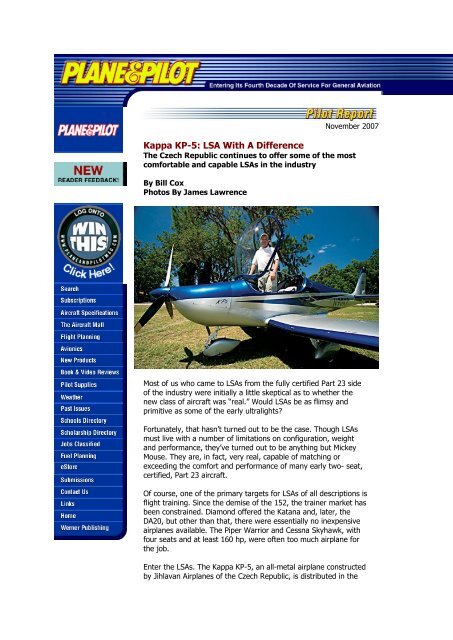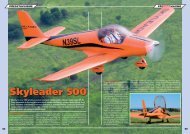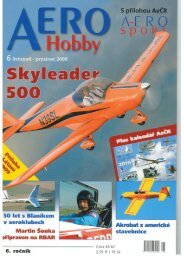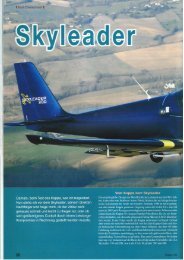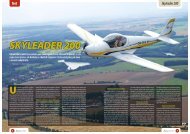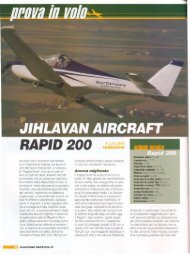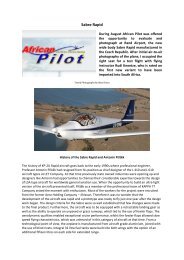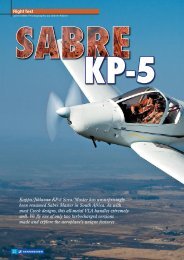Kappa KP-5: LSA With A Difference
Kappa KP-5: LSA With A Difference
Kappa KP-5: LSA With A Difference
You also want an ePaper? Increase the reach of your titles
YUMPU automatically turns print PDFs into web optimized ePapers that Google loves.
November 2007<br />
<strong>Kappa</strong> <strong>KP</strong>-5: <strong>LSA</strong> <strong>With</strong> A <strong>Difference</strong><br />
The Czech Republic continues to offer some of the most<br />
comfortable and capable <strong>LSA</strong>s in the industry<br />
By Bill Cox<br />
Photos By James Lawrence<br />
Most of us who came to <strong>LSA</strong>s from the fully certified Part 23 side<br />
of the industry were initially a little skeptical as to whether the<br />
new class of aircraft was “real.” Would <strong>LSA</strong>s be as flimsy and<br />
primitive as some of the early ultralights<br />
Fortunately, that hasn’t turned out to be the case. Though <strong>LSA</strong>s<br />
must live with a number of limitations on configuration, weight<br />
and performance, they’ve turned out to be anything but Mickey<br />
Mouse. They are, in fact, very real, capable of matching or<br />
exceeding the comfort and performance of many early two- seat,<br />
certified, Part 23 aircraft.<br />
From The Editors of<br />
Plane&Pilot<br />
Of course, one of the primary targets for <strong>LSA</strong>s of all descriptions is<br />
flight training. Since the demise of the 152, the trainer market has<br />
been constrained. Diamond offered the Katana and, later, the<br />
DA20, but other than that, there were essentially no inexpensive<br />
airplanes available. The Piper Warrior and Cessna Skyhawk, with<br />
four seats and at least 160 hp, were often too much airplane for<br />
the job.<br />
Enter the <strong>LSA</strong>s. The <strong>Kappa</strong> <strong>KP</strong>-5, an all-metal airplane constructed<br />
by Jihlavan Airplanes of the Czech Republic, is distributed in the
Get Your<br />
Copy Today!<br />
States by <strong>Kappa</strong> Aircraft of Pocono Pines, Pa. Technically, the<br />
current <strong>KP</strong>-5 is an improved model from the original, featuring<br />
thicker wing skins, a widened fuselage and a narrower center<br />
console, for improved leg room.<br />
Like so many other aircraft in the <strong>LSA</strong> class, the <strong>KP</strong>-5 uses the<br />
economical Rotax 912ULS engine, a powerplant almost ideally<br />
suited for use in homebuilt and other lightweight aircraft. In<br />
addition to delivering 100 hp for five minutes, then 95 hp<br />
continuously, the popular Rotax sports a 1,500-hour TBO. Better<br />
still, the 912ULS weighs only 141 pounds, an especially important<br />
consideration when installed in an airplane that can’t legally weigh<br />
more than 1,320 pounds.<br />
The Rotax translates power to thrust via a fixed-pitch, 68-inch,<br />
Woodcomp, three-blade prop, not surprisingly, a combination<br />
wood/composite design. A spinner is standard on the <strong>Kappa</strong>.<br />
The <strong>KP</strong>-5 is fairly conventional in design and is all-aluminum in<br />
construction. It incorporates a GA(W)-1 airfoil at the roots,<br />
tapering to a -2 at the tips. The wing incorporates small winglets<br />
at the tips to help control stalls and also features electric Fowler<br />
flaps to reduce stall speed. Apparently, the combination works<br />
fairly well, as the <strong>KP</strong>-5 stops flying at an insignificant 33 knots.<br />
Landing gear is tricycle-style with a steerable nosegear and trailing<br />
link dampening to smooth the landings. Standard fuel load is 17<br />
gallons, located in 8.5-gallon leading-edge tanks in each wing.<br />
Gross weight is 1,278 pounds, and if you need to maximize<br />
payload, you’ll probably live with the standard tanks.<br />
Many pilots opt for the eight-gallon aux tanks to boost total<br />
capacity to 25 gallons. At a burn rate of 5.3 gph, the big tanks<br />
provide an endurance of about 3.5 hours plus reserve at max<br />
cruise. Pulled back to 55%, you can add an hour to that time, but<br />
neither of those time spans is a limitation in training mode.<br />
The canopy hinges at the front, revealing a nicely furnished cabin<br />
by AirTex, a Pennsylvania company. The cockpit is generous in<br />
dimension, a full 47.2 inches across, and that qualifies it as a true<br />
general aviation wide body, not all that common in an <strong>LSA</strong>. <strong>Kappa</strong><br />
employs a clever trick that’s been used before to provide more<br />
cross-sectional room. The two pilot seats are staggered, with the<br />
right bucket mounted six inches aft of the left, just enough to<br />
displace the pilot and copilot’s elbows and shoulders. Stick and<br />
rudder pedals on the right side are displaced appropriately.<br />
Engine start and taxi are conventional for an <strong>LSA</strong>, but proper stick<br />
position is important to keep the airplane stable in any significant<br />
crosswind. The good news about nosewheels is that they’re far<br />
easier to manage on the ground than tailwheels. Taxiing the<br />
<strong>Kappa</strong> is relatively easy with the nosegear providing 15 degrees of<br />
deflection to each side. Braking is via a centrally mounted<br />
handbrake. The airplane’s light weight is apparent during ground<br />
operations, an advantage in this case.<br />
Unleash the Rotax, and the <strong>KP</strong>-5 accelerates better than you<br />
might expect. It leaps off in less than 500 feet with little effort and
outclimbs your expectations. <strong>With</strong> two aboard and full fuel, expect<br />
better than 1,000 fpm. The Rotax is rated for 100 hp (5,800<br />
engine rpm) for the first five minutes, then must be reduced to 95<br />
hp (5,500 rpm) for max continuous climb.<br />
On the way uphill, you can’t help but notice the excellent visibility<br />
through the semi-bubble canopy. The view to the rear is slightly<br />
blocked by the aft turtledeck, so you may not spot the airplane<br />
that’s about to eat you, but at least you can take consolation<br />
that’s it’s probably not another <strong>LSA</strong>.<br />
That’s because the <strong>KP</strong>-5 is modestly quick, near the upper speed<br />
limit set by the FAA. Establish power at 5,000 rpm (75% power)<br />
under optimum conditions, and you’ll see roughly 115 knots.<br />
Speed isn’t necessarily the only reason you’d buy an <strong>LSA</strong>, but the<br />
<strong>Kappa</strong> offers more than enough for less than too much.<br />
If you use max cruise power, you can expect to range out just<br />
under 400 nm before you’ll need a refueling stop. For those<br />
strange people who like to fly slow, range may be extended by as<br />
much as 100 nm.<br />
You could probably even plant a <strong>Kappa</strong> off airport if necessary.<br />
Those big Fowler flaps droop to 35 degrees and cover almost a<br />
third of the inboard trailing edge. The result is approaches at 45<br />
knots (still 1.35 Vso) without that verge-of-destruction feeling. The<br />
gear absorbs impacts well, and even a student should be able to<br />
stop the <strong>KP</strong>-5 in well under 600 feet, if necessary.<br />
The airplane is ideally suited as a relatively inexpensive trainer or<br />
as a cross-country cruiser, and that’s likely how many of the type<br />
will be used. The stall is benign, control response won’t get ahead<br />
of a typical student and operating costs are about as minimal as<br />
they get.<br />
Base price for a bare-bones <strong>KP</strong>-5 is $105,000. Add a basic<br />
day/VFR package (Garmin SL-40 com, panel-mounted 396 GPS<br />
and a 320 transponder), and you’re up to $115,000. The top<br />
option includes an autopilot and a full glass panel with EFIS and<br />
EMS (the Cross-Country Edition) for $137,000.<br />
Somehow, I can’t help thinking most of these <strong>LSA</strong>s will be sold in<br />
basic airplane configuration or day/VFR at most, no ups, no<br />
extras. The training mission doesn’t demand all the extras, and<br />
students will probably enjoy the <strong>Kappa</strong> <strong>KP</strong>-5 most when its<br />
equipped least.<br />
SPECS: <strong>Kappa</strong> <strong>KP</strong>-5<br />
Return to Top
<strong>Kappa</strong> <strong>KP</strong>-5<br />
From The Editors<br />
of Plane&Pilot<br />
SPECIFICATIONS<br />
Base price: $105,000<br />
Engine make/model:<br />
Rotex<br />
912ULS<br />
TBO (hrs.): 1500<br />
Horsepower on<br />
takeoff:<br />
Fuel type:<br />
Propeller type:<br />
Landing gear type:<br />
Max ramp weight<br />
(lbs.):<br />
100<br />
100/100LL<br />
68 in./FP/<br />
3-blade<br />
Woodcomp<br />
Tri./Fixed<br />
1278<br />
Gross weight (lbs.): 1278<br />
Landing weight (lbs.): 1278<br />
Empty weight, std.<br />
(lbs.):<br />
695<br />
Useful load, std. (lbs.): 583<br />
Usable fuel, std.<br />
(gals.):<br />
Usable fuel, opt.<br />
(gals.):<br />
17<br />
25
Payload, full std. fuel<br />
(lbs.):<br />
Wingspan:<br />
Overall length:<br />
Height:<br />
481<br />
Wing area (sq. ft.): 128<br />
Wing loading<br />
(lbs./sq.ft.):<br />
Power loading<br />
(lbs./hp):<br />
Seating capacity: 2<br />
32 ft. 6 in.<br />
23 ft. 7 in.<br />
8 ft. 7 in.<br />
9.9<br />
12.8<br />
Cabin width (in.): 47.2<br />
PERFORMANCE<br />
FUEL<br />
CONSUMPTION:<br />
75% power (gph): 5.3<br />
55% power (gph): 4.9<br />
CRUISE SPEED:<br />
75% power (kts.): 115<br />
MAX RANGE:<br />
75% power (nm): 400<br />
Vso (kts.): 33<br />
Best rate of climb, SL<br />
(fpm):<br />
Takeoff ground run<br />
(ft.):<br />
Landing ground run<br />
(ft.):<br />
1100<br />
452<br />
495<br />
Source: <strong>Kappa</strong> Aircraft<br />
PLANE AND PILOT MAGAZINE is a publication of the<br />
Werner Publishing Corporation<br />
12121 Wilshire Blvd, 12th Floor<br />
Los Angeles, CA 90025<br />
Copyright© 2001 Werner Publishing Corp.


